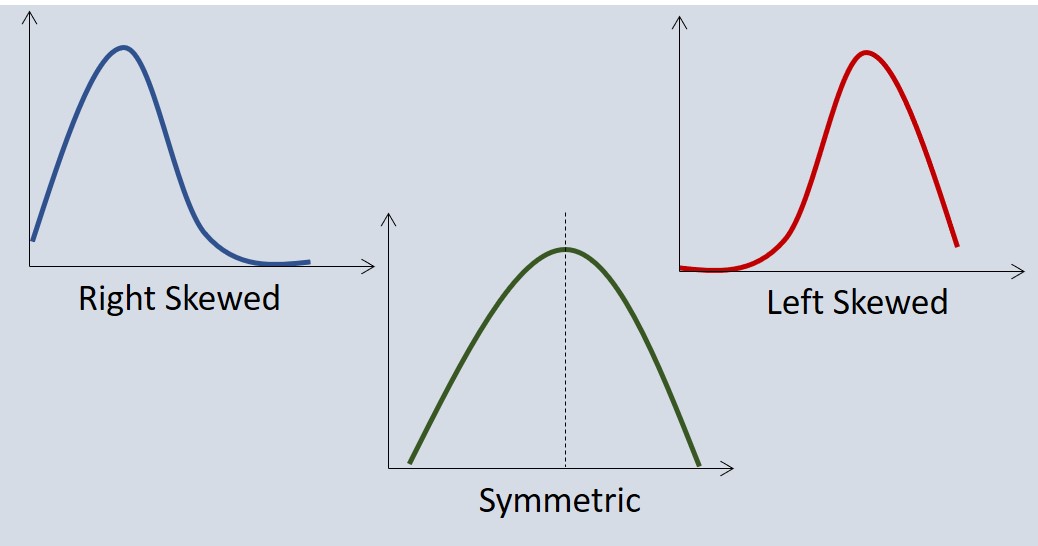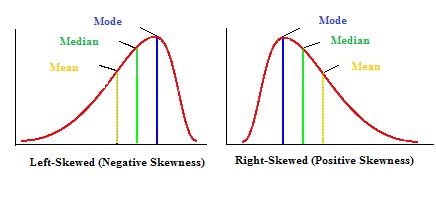As for when the center is the mean then standard deviation should be used since it measure the distance between a data point and the mean. 252 views View upvotes Related Answer Mark Harrison.

How Do We Measure The Degree Of Departure From Normality Blogs Sigma Magic
Central Tendency Measures in Negatively Skewed Distributions Unlike normally distributed data where all measures of central tendency mean median and mode equal each other with negatively skewed data the measures are dispersed.

. Below you will see how the direction of skewness impacts the order of the mean median and mode. It is often used alongside the median to describe the center and spread of skewed distributions. A distribution is said to be skewed when the data points cluster more toward one side of the scale than the other.
Although the measures of center did. Inter-quartile range IQR Standard deviation. One way to measure the spread also called variability or variation of the distribution is to use the approximate range covered by the data.
From looking at the histogram we can approximate the smallest observation min and the largest observation max and thus approximate the range. What is the best measure of spread for a skewed distribution. The best measure of spread when the median is the center is the IQR.
Spread indicates how far individual values tend to fall from the center of the distribution. Skewness measures the deviation of a random variables given distribution from the normal distribution which is symmetrical on both sides. Skewness is a way to describe the symmetry of a distribution.
A distribution is right skewed if it has a tail on the right side of the distribution. The standard deviation is a number that measures how far data values are from their mean. A distribution is left skewed if it has a tail on the left side of the distribution.
It is defined as the maximum minus the minimum. Skewness risk occurs when a symmetric distribution is applied to the skewed data. The most common measure of variation or spread is the standard deviation.
There are several statistics which characterize the amount of spread of which the range and the standard deviation are most frequently used. The second most important measure of a distribution is its spread. In order to describe the distribution we therefore need to supplement the graphical display not only with a measure of center but also with a measure of the variability or spread of the distribution.
Two different distributions with the same mean but very different. Measures of the Spread of the Data An important characteristic of any set of data is the variation in the data. Recall that in a skewed distribution the mean is pulled toward the skew.
The IQR can be used as a somewhat rough but very robust measure of spread when outliers may be present. In some data sets the data values are concentrated closely near the mean. Five of the numbers are less than 25 and five are greater.
The mean of the patients with. The median is a better measure of central tendency in skewed distributions and the rank-sum test is closer to a test of medians than of means. You can also do a 5 or 7 or 9 number summary.
A better measure of the center for this distribution would be the median which in this case is 232 25. A distribution is positively skewed. It will depend on exactly what you want to measure but range and interquartile range are good and better together.
Simply showing the five number summary or a Box Plot can be a good way to get all of the information for a skewed dataset in one place. And a distribution has no skew if its symmetrical on both sides. Notice that in this example the mean is greater than the median.
Note that left skewed distributions are sometimes called negatively-skewed. Mean Median Mode Symmetrical For distributions that have outliers or are skewed the median is often the preferred measure of central tendency because the median is more resistant to outliers than the mean. This measurement is obtained by taking the square root of the variance -- which is essentially the average squared distance between population values or sample values and the mean.
In other data sets the data values are more widely spread out from the mean. The standard deviation is a number. In this section we will discuss the three most commonly used measures of spread.
A given distribution can be either be skewed to the left or the right. When it is skewed right or left with high or low outliers then the median is better to use to find the center. Range Inter-quartile range Variance and standard deviation Rule of thumb Skewness Bimodality Range The range is the extent of the data set.
As Figure 14 below shows two distributions can have the same center and general shape in this case a bell curve but have very different spreads. The most common measure of variation or spread is the standard deviation. Apparently the positive biopsy distribution was too skewed for our assumption of symmetry.
When the mean is the most appropriate measure of center then the most appropriate measure of spread is the standard deviation.

Skewness Overview Types How To Measure And Interpret

Positively Skewed Distribution Overview And Applications In Finance

:max_bytes(150000):strip_icc()/Skewness2-41213888936d48728da095f7657b8d7e.png)
0 Comments